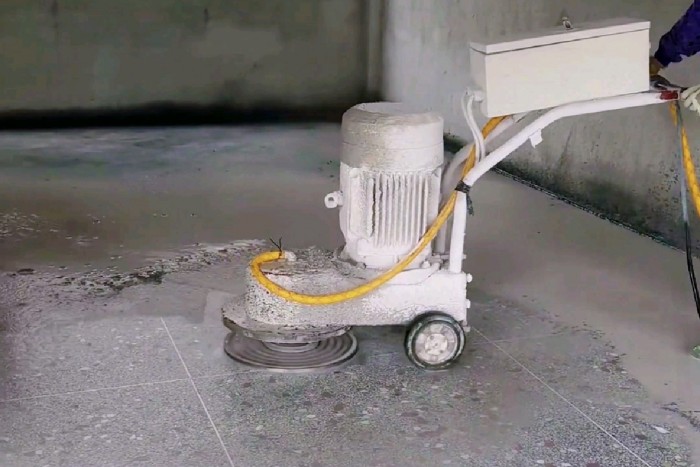
How to Buff Terrazzo Floors?
Importance and Frequency of Rough Grinding in Terrazzo Floor Processing
Rough sanding is a crucial first step in the terrazzo flooring process and is the basis for creating a smooth and beautiful surface. This initial stage is critical to removing burrs, bumps, and any uneven areas on the stone surface that can significantly affect the overall quality and appearance of the finished floor.
The role of coarse grinding
The main purpose of rough grinding is to prepare for the subsequent fine grinding and polishing steps. Rough sanding is an effective way to remove imperfections and ensure that the floor is level and free of any unevenness that could affect the final result. This step is crucial because any remaining bumps or unevenness can cause problems in subsequent processes, such as poor polish adhesion or uneven gloss.
Rough grinding also helps to bring out the aggregate in the terrazzo mix, making the finish more vibrant and visually appealing. By creating a uniform surface, this step improves the overall aesthetic of the floor, making it more attractive in commercial and public spaces.
Coarse grinding frequency
During the terrazzo floor processing process, 2-3 rough grindings are usually required. The reason for doing this multiple times is simple: after the first round of sanding, there may still be some areas that are not completely sanded down. To ensure the flatness of the entire floor, a second or even third round of rough grinding is usually required.
First pass: The initial rough sanding stage is mainly to remove the most obvious imperfections and smooth the surface. This step lays the foundation for subsequent processes.
Second pass: The second round of rough sanding is designed to fix any irregularities that may have been missed in the first pass. It further refines the surface, ensuring it is fully prepared for fine grinding.
Third pass (if necessary): In some cases, a third pass of rough sanding may be necessary, especially for floors with uneven surfaces or that were not sufficiently smoothed in the previous steps. This additional sanding step ensures the surface is completely flat and level, ready for the next stage of construction.
Rough grinding is an essential step in the terrazzo flooring process, laying the foundation for a high-quality surface. Rough grinding can effectively remove burrs, bumps and uneven areas, preparing for subsequent fine grinding and polishing, ultimately improving the beauty and durability of the floor. The frequency of coarse sanding - usually 2-3 times - will ensure that any imperfections are completely resolved, resulting in a smooth, even surface.
Importance and Frequency of Fine Grinding in Terrazzo Floor Processing
Fine grinding is a vital step in the terrazzo flooring process, following the initial rough grinding stage. This stage is essential to achieving a finely polished surface, which enhances the overall aesthetics and functionality of the floor.
Purpose of fine grinding
The main purpose of fine sanding is to make the floor smoother after rough sanding. While rough sanding is effective in removing larger imperfections, it may leave marks and scratches that need to be dealt with. Fine sanding can eliminate these imperfections and ensure that the floor surface is not only smooth, but also beautiful.
Fine grinding also plays a vital role in enhancing the overall quality of terrazzo floors. By refining the surface, fine grinding can bring out the texture of the terrazzo mix by making it more delicate. This step is essential to achieve the desired aesthetic, making the floor more attractive in commercial and public spaces.
Fine grinding frequency
Usually, the fine grinding process of terrazzo floor needs to be carried out 3-4 times. The purpose of multiple fine grinding is to ensure that every detail of the floor is fully polished and any defects left by the rough grinding stage are eliminated. The following is a detailed description of the fine grinding process:
First pass: The initial fine sanding step is mainly to polish the surface and remove any visible marks left by the rough sanding. This step lays the foundation for further fine sanding.
Second pass: A second round of fine sanding continues to refine the surface and repair any remaining scratches or uneven areas. This pass is essential to achieve a more even texture.
Third pass: The third pass of fine grinding further improves the smoothness of the floor and ensures that it reaches the required quality standard. The focus of this stage is to make the surface more perfect.
Fourth pass (if necessary): In some cases, a fourth pass of finishing sanding may be necessary, especially for floors that require extreme smoothness or have intricate patterns. This additional grinding step ensures that the floor reaches the ultimate level of refinement.
Effect of fine grinding
The impact of fine grinding on terrazzo floors is significant and multifaceted:
Smoother surface: Fine sanding creates a smoother surface, which is essential for both aesthetics and practicality. Smooth floors are easier to clean and maintain, making them ideal for high-traffic areas.
Improves aesthetics: Fine sanding improves the visual effect of the terrazzo by removing marks and scratches, and making the color and pattern of the aggregate more vivid. This fine sanding helps improve the overall aesthetics of the floor.
Improved durability: A well-sanded floor is more resistant to wear and tear. Fine sanding helps create a surface that stands up to everyday use and extends the life of your terrazzo.
Better light reflection: Smoother surfaces reflect light better, creating brighter, more welcoming spaces. This effect is especially important in commercial environments, where ambience is crucial.
Fine grinding is an essential step in the processing of terrazzo flooring, which usually requires 3-4 times to achieve the ideal smoothness and fineness. Fine grinding can effectively eliminate the marks and defects left by the rough grinding stage and improve the overall beauty and functionality of the floor. The importance of this step cannot be overstated as it sets the stage for the final polishing phase and ensures the terrazzo floor is finished to the highest quality standards.
Importance and Frequency of Polishing in Terrazzo Floor Processing
Polishing is the final, critical step in the treatment of terrazzo floors and is essential to improving the overall appearance and functionality of the floor. This step not only creates a stunning mirror effect, but also improves the durability and safety of the floor.
The Importance of polishing
The main purpose of polishing is to enhance the gloss of the terrazzo floor, giving it a visually striking surface that reflects light beautifully. A well-polished floor not only enhances the aesthetics of a space, but also creates a warmer and more professional atmosphere, which is particularly important in commercial and public places.
In addition to aesthetics, polishing has several functional uses:
Enhanced wear resistance: Polishing creates a protective layer on the surface of the terrazzo, making it more resistant to scratches, stains, and daily wear and tear. This enhanced durability is essential in areas with high traffic and frequent floor use.
Improved slip resistance: Polishing the surface can enhance the slip resistance of the floor, especially when using the right polish. This is essential for ensuring safety in environments where spills or moisture may occur.
Easier to maintain: Polished terrazzo floors are easier to clean and maintain. The smooth surface prevents dust and dirt from settling, allowing for a faster and more efficient cleaning process.
Polishing frequency
Typically, the final treatment of terrazzo floors requires 2-3 polishings. The purpose of multiple polishings is to ensure that the floor reaches the desired gloss and smoothness. The following is a detailed description of the polishing process:
First pass: The initial polishing step is mainly to create a basic gloss. This step helps to remove minor scratches left over from the previous sanding process and begins to improve the gloss of the floor.
Second pass: The second coat further refines the surface, increases the gloss and ensures the floor reflects light effectively. This coat is essential to achieve a more even, smoother appearance.
Third pass (if necessary): In some cases, a third coat may be necessary to achieve optimal gloss and smoothness. This extra step is especially important for floors that require a high gloss or have intricate patterns.
Polishing is an indispensable step in the treatment of terrazzo floors, which is both beautiful and practical. After 2-3 polishing, the floor can achieve a mirror effect, which is not only beautiful, but also improves its durability and safety.
In Conclusion
Treating terrazzo floors is a delicate process that requires meticulous attention to detail. Ensuring that the rough, fine and polishing steps are performed with the proper frequency and technique will maximize the quality and beauty of the floor, ultimately extending its life. In addition, using the right terrazzo floor polishing pads and polishes, and mastering the correct application techniques, are essential to achieving the best treatment results. Investing in the right polishing technology will not only enhance the appearance of your terrazzo floor, but will also ensure that it remains functional and beautiful for years to come.
-
Online service
-
Official wechat
account
-
QQ:40933769
-
E-mail:
sales@z-lion.com
Online service
Please feel free to give your inquiry in the form below. We will reply you in 24 hours.


